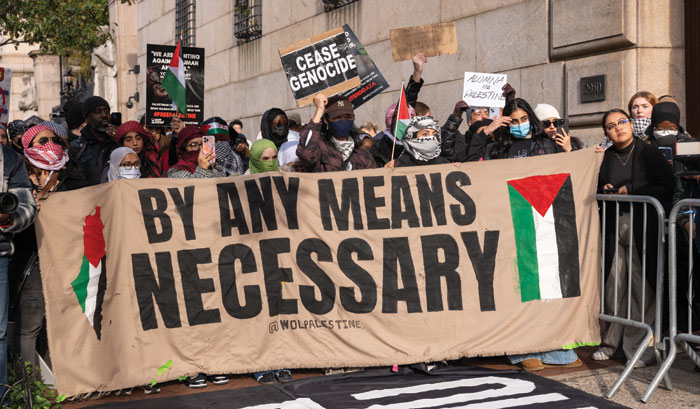
One verse, five voices. Edited by Salvador Litvak, the Accidental Talmudist
This shall be the law of the metzora (the person afflicted with tzara’at), on the day of his cleansing: He shall be brought to the kohen (the priest).
– Lev. 14:2
Rabbi Rebecca Schatz
Assistant Rabbi, Temple Beth Am
Some translations of this verse explain v’huva el hakohen as, “when it has been reported to the priest.” However, the Hebrew is painfully clear regarding the isolation of a leper: “And he will be brought to the priest,” which implies that in isolation he has to wait for someone to bring him before the priest. The Da’at Zkeinim shares that it is written as if “he had come” to the priest, since people were told to keep away from the leper. We could read this as sad and distant or empowering and a display of independence. The leper needs to see the priest to move from tzara’at to purity, but how they come together depends on support or allowances from community involvement. How hard do we try to bring the afflicted person back amongst us?
I’m reminded of a sugiya on Brachot 5b that shares of a time when Rabbi Hiyya bar Abba fell ill and Rabbi Yochanan asks for his hand to lift him up out of his illness and into health. Then in turn when Rabbi Yochanan falls ill Rabbi Hanina comes and asks for his hand to lift him up to health. So the rabbis of the Talmud ask, why could Rabbi Yochanan not just bring himself to health if he was able to heal others, and his response was, “a prisoner cannot free themself from prison.”
After years and many moments of isolation, we need to remember that like the leper we need help coming back into community. We might have the initial instinct to come back, but we need others to return us to the reasons, the feelings and the holiness of being together.
Rabbi Chaim Singer-Frankes
Multi-faith Chaplain, Kaiser Permamente Medical Center, Panorama City
Our Torah embraces matters private and public; personal concerns and those shared among many. In this era, it is a familiar tension which we navigate both intimately and consequentially across these same congested boundaries. Classically, Moshe’s headaches as a leader involve the failings of the People Israel: our derelictions of faith and our yearning to correct through wisdom and holy counsel.
Therefore, it is curious that Metozrah’s passage personifies the leader (priest) as immunologist, in management of diseases intractable and ungovernable. With the former we journey back to God and community through deeds and sacrifice. Tza’arat by contrast, is in a category of blight ostensibly beyond our control. It almost feels like an admission by The Holy One as if to say, ‘I can’t help you with this one, so here’s the best way to deal with it.’
Accordingly, I am moved by the weight placed upon the priest in surveying and determining the ritual/social “cleanliness” of the Israelites.
Consider the social responsibility inherent to a thumbs up or down declaring a person’s fitness, closing doors or opening them. Inevitably, the public health officers of today come to mind, with their reams of data as reflections of the Torah’s words enumerating degree of spread, indicia of transmissibility, connoting danger of contagion. Let us then be mindful of the burdens heaped upon those with studied knowledge, endowed by God and people with the freight of momentous decisions, often unpopular and suffering scorn regardless which judgments they reach.
Marcus J Freed
Actor, author and Jewish educator,
marcusjfreed.com
There was a man called Rachel who sold drugs. The Rabbis tell the story of a merchant (Midrash Vayikra Rabbah, 16:2), and how he went from town to town proclaiming “who wants the drug of life?” Rabbi Yannai was interested. The man produced a book of Psalms, quoting “who is the man who desires life? …guard your tongue from evil” (Psalms 34:14-15).
The Ishbitzer Rebbe explained why the man was called Rachel – which in Hebrew is Rochel, spelled quite differently from the female name Rachel – because it comes from the word rechilut, meaning talebearing, or gossip. If not guarding our tongue leads to death, then we know which path to take.
The Biblical metzorah is one who has an illness that is a result of slandering others. We live in an age where people are harshly punished for their words, whether it is a 10-year-old tweet, a badly-timed joke in poor taste, or an offhand comment. We’ve seen people lose jobs, television series get cancelled, and lives ruined. Whilst this isn’t quite tzaras (the Biblical illness) it does cause tsuris (the Yiddish word for worries, stress, woe or grief).
Have you had that moment when you’ve spoken negatively about someone, later see them, and feel a bit guilty? At that moment the relationship has lost a tiny bit of its vitality. We all have access to this life force, by choosing carefully how to use our words. This is available to everybody, and you don’t even need to be named Rachel.
Rabbanit Alissa Thomas-Newborn
The first step of reintegration into society is for the metzora to meet with the kohen. The kohen goes outside of the camp and affects the ritual process of purification and return. The Gemara famously teaches that the imprisoned cannot free himself from jail, that the afflicted cannot heal himself alone. Jews need community, we need one another in order to get through life’s ups and downs. Sometimes to hold each other’s hand as we cross the threshold into the next chapter.
In the extreme context of the metzora’s spiritual reentry, the kohen embodies and models this ethic for us, and it is a role that holds tremendous responsibility. The kohen wasn’t merely the facilitator of ritual. He was the gatekeeper, the face that would greet and guide the person living on the outside.
What does it mean for us to be the gatekeeper? To facilitate space for another? To meet in the midst of vulnerability and support recovery? Who has been in that role for us? Often everything that comes after such an encounter is influenced by the tenor and heart evident in that first most liminal of moments.
Whether in a passing exchange or in a profound circumstance, we each have this power. And using it with empathy, vision, and wisdom is central in serving the Divine as mamlechet kohanim, a kingdom of priests.
Nina Litvak
Writer, AccidentalTalmudist.org
The procedure for purifying a metzora from his punishing skin disorder involves slaughtering a bird, then tying together cedar and hyssop with red thread and dipping the cedar/hyssop stick and a live bird into the dead bird’s blood. Cedar represents strength; unlike most wood, it stays solid during extreme changes in weather and does not shrink, swell, or decay. Hyssop, on the other hand, represents humility. It is a soft and small herb, easy to crush or overlook. Since the metzora’s sin – evil speech – was caused by his own arrogance, the humble hyssop imparts an important lesson. But what about the tall and proud cedar? The metzora has already been brought down from the heights of arrogance and pride. What does he need to learn from the cedar wood?
The Hassidic master known as the Chidushei Harim (Poland, 19th century) explained that humility and conceit are both integral parts of being a virtuous person. In living a Torah life we must be strong and proud, but in matters pertaining to our own ego and comfort, we must be soft and humble. To be a Jew is to constantly balance competing forces: chesed (lovingkindness) and gevurah (judgement); yetzer tov (good inclination) and yetzer hara (evil inclination). We are adjured by God through Moses not to stray from the path of Torah, neither to the right or the left. How can we achieve this delicate balance? To paraphrase Rebbe Nachman, the key to staying balanced is first to banish fear.























 More news and opinions than at a Shabbat dinner, right in your inbox.
More news and opinions than at a Shabbat dinner, right in your inbox.